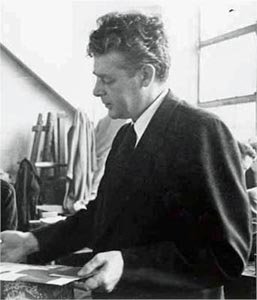
Abstract art uses visual language of shape, form, color and line to create a composition which may exist with a degree of independence from visual references in the world. Western art had been, from the Renaissance up to the middle of the 19th century, underpinned by the logic of perspective and an attempt to reproduce an illusion of visible reality. By the end of the 19th century many artists felt a need to create a new kind of art which would encompass the fundamental changes taking place in technology, science and philosophy. The sources from which individual artists drew their theoretical arguments were diverse, and reflected the social and intellectual preoccupations in all areas of Western culture at that time.

De Stijl, Dutch for "The Style", also known as Neoplasticism, was a Dutch art movement founded in 1917 in Leiden. De Stijl consisted of artists and architects. In a more narrow sense, the term De Stijl is used to refer to a body of work from 1917 to 1931 founded in the Netherlands. Proponents of De Stijl advocated pure abstraction and universality by a reduction to the essentials of form and colour; they simplified visual compositions to vertical and horizontal, using only black, white and primary colors.

Theo van Doesburg was a Dutch artist, who practiced painting, writing, poetry and architecture. He is best known as the founder and leader of De Stijl. He was married to artist, pianist and choreographer Nelly van Doesburg.

Broadway Boogie Woogie is a painting by Piet Mondrian completed in 1943, after he had moved to New York in 1940. Compared to his earlier work, the canvas is divided into many more squares. Although he spent most of his career creating abstract work, this painting is inspired by clear real-world examples: the city grid of Manhattan, and boogie-woogie, an African-American Blues music Mondrian loved. The painting was bought by the Brazilian sculptor Maria Martins for the price of $800 at the Valentine Gallery in New York City, after Martins and Mondrian both exhibited there in 1943. Martins later donated the painting to the Museum of Modern Art in New York City.
Charmion von Wiegand (1896–1983) was an American journalist, abstract painter, writer, collector, benefactor and art critic. She was the daughter of Inez Royce, an artist, and Karl Henry von Wiegand. Karl Henry von Wiegand was the German-born journalist known for wartime reporting.
Painting – artwork in which paint or other medium has been applied to a surface, and in which area and composition are two primary considerations.

Albert Carel Willink was a Dutch painter who called his style of Magic realism "imaginary realism".

The Museum of Fine Arts, Houston (MFAH), is an art museum located in the Houston Museum District of Houston, Texas. With the recent completion of an eight-year campus redevelopment project, including the opening of the Nancy and Rich Kinder Building in 2020, it is the 12th largest art museum in the world based on square feet of gallery space. The permanent collection of the museum spans more than 6,000 years of history with approximately 70,000 works from six continents.

Harry Holtzman was an American artist and founding member of the American Abstract Artists group.

Pieter Cornelis Mondriaan, after 1906 Piet Mondrian, was a Dutch painter and art theoretician who is regarded as one of the greatest artists of the 20th century. He is known for being one of the pioneers of 20th-century abstract art, as he changed his artistic direction from figurative painting to an increasingly abstract style, until he reached a point where his artistic vocabulary was reduced to simple geometric elements.

Burgoyne A. Diller was an American abstract painter. Many of his best-known works are characterized by orthogonal geometric forms that reflect his strong interest in the De Stijl movement and the work of Piet Mondrian in particular. Overall, his Geometric abstraction and non-objective style also owe much to his study with Hans Hofmann at the Art Students League of New York. He was a founding member of the American Abstract Artists. Diller's abstract work has sometimes been termed "constructivist". He also did figurative and representational works early in his career working as a muralist for the New York City Federal Arts Project.

Edna Andrade was an American abstract artist. She was an early Op Artist.

George Kendall Shaw was an American painter who was based in New Orleans, with a career spanning a number of art styles—ranging from abstract expressionism to pop art to minimalism to pattern and design to color field—with heightened emotion, pattern, shape, and vivid color predominant. Shaw's work includes a series of 30 paintings based on the Torah of the Old Testament, as well as recent work with pure colors that he terms “Cajun Minimalism.”

Albert Jean Gorin was a French neoplastic painter and constructive sculptor. He was a disciple of Piet Mondrian, and remained true to the concept of rigid geometricism and use of primary colors, but pushed the limits of neoplasticism by introducing circles and diagonals. He was known for his three-dimensional reliefs.
Nancy Haynes is an artist living and working in New York. She was born in Connecticut and shares her time between living in New York City and the Huerfano Valley in Colorado.

Woman with Black Glove is a painting by the French artist, theorist and writer Albert Gleizes. Painted in 1920, after returning to Paris in the wake of World War I, the paintings highly abstract structure is consistent with style of experimentation that transpired during the second synthetic phase of Cubism, called Crystal Cubism. As other post-wartime works by Gleizes, Woman with Black Glove represents a break from the first phase of Cubism, with emphasis placed on flat surface activity and large overlapping geometric planes.

Hassel Smith was an American painter.
Carel Hendrik Blotkamp is a Dutch artist, art historian, writer and critic. He was a professor at the Vrije Universiteit Amsterdam between 1982 and 2007. Apart from his academic career Blotkamp is known for his work in art critique, writing for several newspapers and magazines. He also co-founded several art magazines. Blotkamp is considered an authority on De Stijl and magic realism, and wrote several books on modern artists.

Harriet Korman is an American abstract painter based in New York City, who first gained attention in the early 1970s. She is known for work that embraces improvisation and experimentation within a framework of self-imposed limitations that include simplicity of means, purity of color, and a strict rejection of allusion, illusion, naturalistic light and space, or other translations of reality. Writer John Yau describes Korman as "a pure abstract artist, one who doesn’t rely on a visual hook, cultural association, or anything that smacks of essentialization or the spiritual," a position he suggests few post-Warhol painters have taken. While Korman's work may suggest early twentieth-century abstraction, critics such as Roberta Smith locate its roots among a cohort of early-1970s women artists who sought to reinvent painting using strategies from Process Art, then most associated with sculpture, installation art and performance. Since the 1990s, critics and curators have championed this early work as unjustifiably neglected by a male-dominated 1970s art market and deserving of rediscovery.

Andrew Spence is an American artist known for abstract paintings that combine a minimalist vocabulary with playful references to the observed world. In the 1970s and 1980s, he gained recognition as one of a number of younger artists who were re-examining geometric modernism through a contemporary lens that invited humor and reference to everyday objects and life experience into the tradition. Spence's method of distilling visual phenomena into simple, emblematic images has been compared to Ellsworth Kelly, but his work has differed in its more even balance between abstraction and recognition, intuitive approach, and varied, expressive paint surfaces. Art in America critic Ken Johnson wrote that his work maintains "an ironic tension between lofty purism of modernist geometry and earth-bound ordinariness of the vernacular sources." In later paintings, Spence has increasingly obscured the original inspirations of his abstractions, in both form and titling. His work belongs to the permanent collections of the Metropolitan Museum of Art, Museum of Modern Art, and Whitney Museum of American Art, among others. He has received a Guggenheim Fellowship and awards from the American Academy of Arts and Letters and National Endowment for the Arts.
















